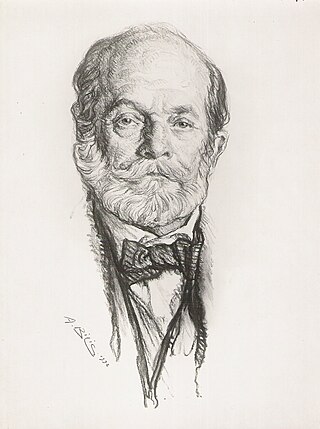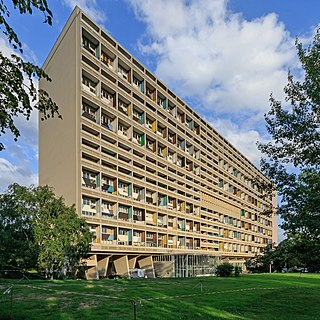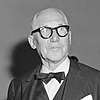
Charles-Édouard Jeanneret, known as Le Corbusier, was a Swiss-French architect, designer, painter, urban planner and writer, who was one of the pioneers of what is now regarded as modern architecture. He was born in Switzerland and acquired French nationality by naturalization on 19 September 1930. His career spanned five decades, in which he designed buildings in Europe, Japan, India, as well as North and South America. He considered that "the roots of modern architecture are to be found in Viollet-le-Duc".

Modern architecture, or modernist architecture, was an architectural movement or architectural style based upon new and innovative technologies of construction, particularly the use of glass, steel, and reinforced concrete; the idea that form should follow function (functionalism); an embrace of minimalism; and a rejection of ornament. It emerged in the first half of the 20th century and became dominant after World War II until the 1980s, when it was gradually replaced as the principal style for institutional and corporate buildings by postmodern architecture. According to Le Corbusier the roots of the movement were to be found in the works of Eugène Viollet le duc.

Auguste Perret was a French architect and a pioneer of the architectural use of reinforced concrete. His major works include the Théâtre des Champs-Élysées, the first Art Deco building in Paris; the Church of Notre-Dame du Raincy (1922–23); the Mobilier National in Paris (1937); and the French Economic, Social and Environmental Council building in Paris (1937–39). After World War II he designed a group of buildings in the centre of the port city of Le Havre, including St. Joseph's Church, Le Havre, to replace buildings destroyed by bombing during World War II. His reconstruction of the city is now a World Heritage Site for its exceptional urban planning and architecture.

The Unité d'habitation is a modernist residential housing typology developed by Le Corbusier, with the collaboration of painter-architect Nadir Afonso. It formed the basis of several housing developments throughout Europe designed by Le Corbusier and sharing the same name.
The year 1932 in architecture involved some significant events.
Villa Jeanneret and Villa La Roche are two houses in Paris, designed by Le Corbusier and Pierre Jeanneret in 1923-1925 and renovated by Charlotte Perriand in 1928. No longer inhabited, they house the Fondation Le Corbusier museum and archives. They are located at 8-10 square du Docteur-Blanche, 16th arrondissement, Paris. Villa Jeanneret is not open to the public.

The Louvre Saint-Honoré building is a historic structure in Paris, occupying an entire urban block between the rue de Rivoli, the place du Palais-Royal, the rue Saint-Honoré, and the rue de Marengo, with a total floor surface of 47,000 square meters. It was originally erected in the early 1850s by the Pereire brothers who in 1855 opened an iconic hotel, the Grand Hôtel du Louvre, and an innovative street-level department store, branded from 1863 the Grands Magasins du Louvre. While the Grand Hôtel closed in 1887, the Grands Magasins expanded and kept operating in the building until 1974. From 1978 to 2016 they were succeeded by a specialized mall of antiques shops, the Louvre des Antiquaires, while the upper floors were repurposed as rented office space. Since 2020, the building's lower levels have been undergoing conversion to become the new flagship home of the Fondation Cartier pour l'Art Contemporain.

The Villa Jeanneret-Perret is the first independent project by Swiss architect Le Corbusier. Built in 1912 in La Chaux-de-Fonds, Charles-Edouard Jeanneret's hometown, it was designed for his parents. Open to the public since 2005, the house is under the patronage of the Swiss National Commission for UNESCO and has been proposed by the Swiss Government for inscription on the World Heritage List.
Fondation Le Corbusier is a private foundation and archive honoring the work of architect Le Corbusier. It operates Maison La Roche, a museum located in the 16th arrondissement at 8-10, square du Dr Blanche, Paris, France, which is open daily except Sunday. The Maison La Roche was temporarily closed for renovation in 2008–2009.
Georges-Henri Pingusson was a French architect.
Villa Meyer (1925–1926) is an unbuilt project which was supposed to be built in Neuilly-sur-Seine, in downtown Paris. Four designs were created for this house by Swiss architect Le Corbusier, but it was never built. This is the first project into which Le Corbusier incorporated "free plan" and "free facade" into his design. These ideas later become two of Corbusier's famous Five Points of Architecture. Domino Frame is also an outcome of this experimental design, which became the dominant design concept of Corbusier's later works.

Immeuble Clarté is an apartment building in Geneva designed by Le Corbusier and Pierre Jeanneret starting from 1928 and built in 1931–32. It has eight stories comprising 45 free plan units of diverse configurations and sizes. It is one of Le Corbusier's key early projects in which he explored the principles of modernist architecture in apartment buildings, which later led to the Unité d'Habitation design principle.

Villa La Roche, also Maison La Roche, is a house in Paris, designed by Le Corbusier and his cousin Pierre Jeanneret in 1923–1925. It was designed for Raoul La Roche, a Swiss banker from Basel and collector of avant-garde art. Villa La Roche now houses the Fondation Le Corbusier.
Le Corbusier's Five Points of Architecture is an architecture manifesto conceived by architect, Le Corbusier. It outlines five key principles of design that he considered to be the foundations of modern architectural discipline, which would be expressed though much of his designs.

Unité d'Habitation of Berlin is a 1958 apartment building located in Berlin-Westend, Germany, designed by Le Corbusier following his concept of Unité d'Habitation. Le Corbusier's Unité d'Habitation concept was materialised in four other buildings in France with a similar design. The building is constructed in béton brut and is part of the initial architecture style we know today as brutalism. The structure was built with on site prefab cast concrete panels and poured ceiling slabs. The Modulor system is the base measure of the Unité and Corbusier used not more than 15 Modulor measures to construct the entire structure form. Ultimately the work has been eliminated from Le Corbusier's oeuvre, which he confirmed himself until his death in 1965 and which has also been confirmed posthumous in 1967 in his last authorized publication of his work.

Edith Schreiber-Aujame was a Franco-American architect and urban planner. She was born in Rymanów, Poland and died in France.

La Cité de Refuge is a building in Paris, France designed by the architect Le Corbusier. It was designed for the Salvation Army and opened in 1933. Since that time it has been occupied by the French Salvation Army. The building, one of Le Corbusier's first urban housing projects, was designated a National Historical Monument of France in 1975.

Pavillon de l'Esprit Nouveau was a model home constructed for the 1925 International Exhibition of Modern Decorative and Industrial Arts in Paris, France. The building was designed by Swiss architects Le Corbusier and Pierre Jeanneret.

The Villa Le Lac, also known as the Villa "Le Lac" Le Corbusier, is a residential building on Lake Geneva in Corseaux, Canton of Vaud, Switzerland, designed by Swiss architects and cousins Le Corbusier and Pierre Jeanneret between 1923 and 1924 for Le Corbusier's parents. It is an example of residential Modern architecture and showcases three of Le Corbusier's Five Points of Architecture. The building is a designated Swiss Cultural Property of National Significance and was added to the UNESCO World Heritage List in 2016.

The Art Deco movement of architecture and design appeared in Paris in about 1910–12, and continued until the beginning of World War II in 1939. It took its name from the International Exposition of Modern Decorative and Industrial Arts held in Paris in 1925. It was characterized by bold geometric forms, bright colors, and highly stylized decoration, and it symbolized modernity and luxury. Art Deco architecture, sculpture, and decoration reached its peak at 1939 Exposition Internationale des Arts et Techniques dans la Vie Moderne, and in movie theaters, department stores, other public buildings. It also featured in the work of Paris jewelers, graphic artists, furniture craftsmen, and jewelers, and glass and metal design. Many Art Deco landmarks, including the Théâtre des Champs-Élysées and the Palais de Chaillot, can be seen today in Paris.
















